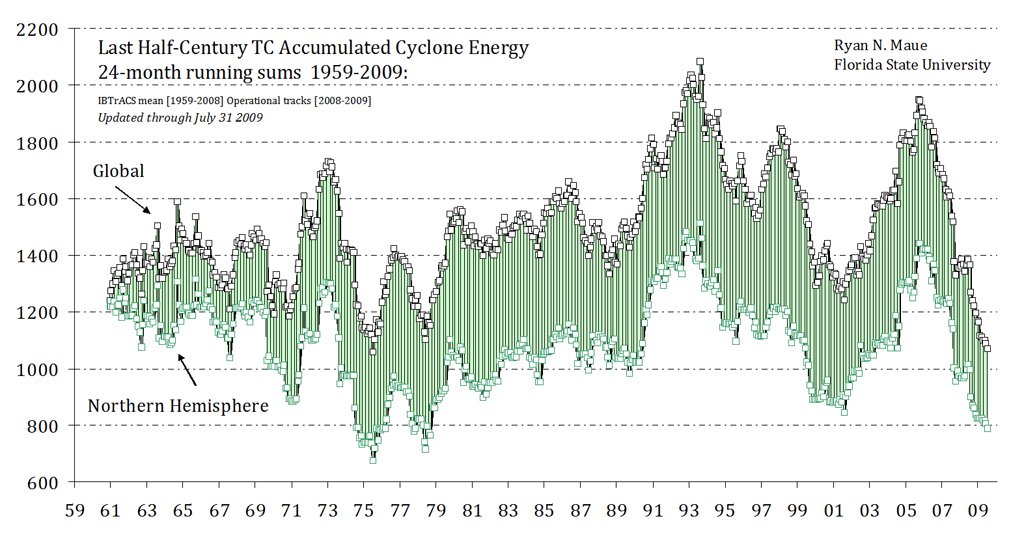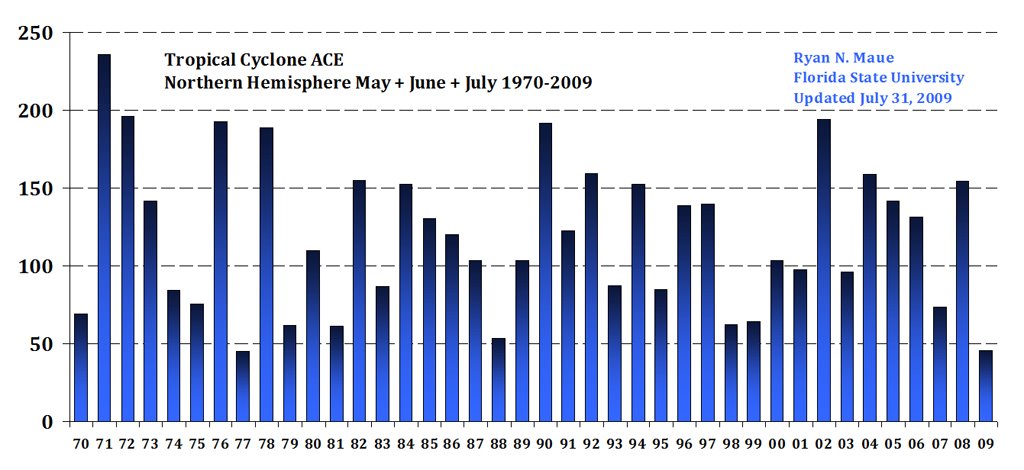2 August 2009
The low level of NH hurricanes and typhoons in summer 2009
Posted by Dave Petley
One of the reasons that the northern hemisphere summer is essentially the global landslide season is that landfalling tropical cyclones (typhoons and hurricanes) represent a rather efficient way of triggering slope failures. This is especially the case in the Caribbean, Taiwan, Japan, SE and S China, the Philippines and Vietnam. Typhoon rain is astonishing to experience for the first time – peak intensities of 100 mm per hour are not unusual in the largest events. The hourly rainfall data below is for the passage across Korea of Typhoon Rusa in 2002, taken from Lee and Choi (2007):
 Note that at Gangneung the peak hourly precipitation was 100.5 mm (4 inches) and the peak 24 hour rainfall was 870.5 mm (35 inches). It is unsurprising that such events cause landslides on a large-scale.
Note that at Gangneung the peak hourly precipitation was 100.5 mm (4 inches) and the peak 24 hour rainfall was 870.5 mm (35 inches). It is unsurprising that such events cause landslides on a large-scale.
The northern hemisphere tropical cyclone season is primarily associated with warm sea surface temperatures, and hence runs primarily through the summer and early autumn months. Interestingly, and for reasons that are far from clear, the energy associated with northern hemisphere tropical cyclones has been reducing for a number of years. Ryan Maue at Florida State University runs a superb web page that tracks tropical cyclone occurrence globally. He has the following graph of global and northern hemisphere tropical cyclone energy (note smoothed using 24 month running sums):
 Levels of tropical cyclone activity are now approaching a 50 year low. However, even by recent standards the level of Northern Hemisphere tropical cyclone activity to date this season has been exceptionally low. Ryan also provides the following graph of Northern Hemisphere tropical cyclone energy (ACE) for the first three months of each season since 1979:
Levels of tropical cyclone activity are now approaching a 50 year low. However, even by recent standards the level of Northern Hemisphere tropical cyclone activity to date this season has been exceptionally low. Ryan also provides the following graph of Northern Hemisphere tropical cyclone energy (ACE) for the first three months of each season since 1979:
 It is not for me to speculate on why tropical cyclone activity should be at such a low level (Ryan is much better qualified to do so), but it is clear that so far the Northern Hemisphere tropical cyclone occurrence has been a damp squib. The occurrence of landslides reflects this (I will post my monthly update in the next few days). This is of course good news in terms of landslides and floods, but it is bad news for farmers who rely on rainfall for irrigation, the hydro-electric industry in these areas, and many others whose livelihood and.or welfare depends upon water derived from tropical cyclones.
It is not for me to speculate on why tropical cyclone activity should be at such a low level (Ryan is much better qualified to do so), but it is clear that so far the Northern Hemisphere tropical cyclone occurrence has been a damp squib. The occurrence of landslides reflects this (I will post my monthly update in the next few days). This is of course good news in terms of landslides and floods, but it is bad news for farmers who rely on rainfall for irrigation, the hydro-electric industry in these areas, and many others whose livelihood and.or welfare depends upon water derived from tropical cyclones.
It will be interesting to see whether level of activity dramatically increase later in the season.
Meanwhile, the S. Asian monsoon remains very weak, with the Indian Meteorological Department noting that total precipitation in the monsoon season is 19% below the long term average. Again, the occurrence of fatal landslides that I have recorded is mirroring this pattern. Meanwhile, much of China is suffering from unusually intense monsoon rains. For example, Shanghai has just suffered its heaviest rainfall for 70 years.


 Dave Petley is the Vice-Chancellor of the University of Hull in the United Kingdom. His blog provides commentary and analysis of landslide events occurring worldwide, including the landslides themselves, latest research, and conferences and meetings.
Dave Petley is the Vice-Chancellor of the University of Hull in the United Kingdom. His blog provides commentary and analysis of landslide events occurring worldwide, including the landslides themselves, latest research, and conferences and meetings.